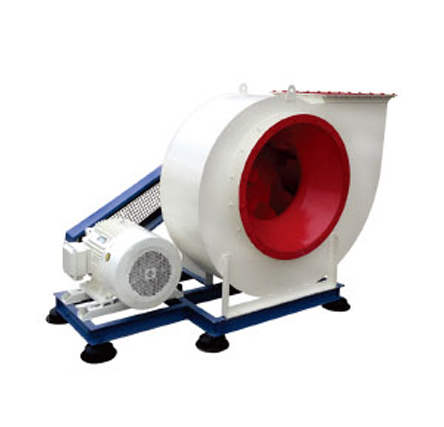The 4-68 centrifugal fan is a general-purpose ventilation device widely used in industrial and civil applications, primarily for air delivery and ventilation in factories, large buildings, mines, and similar environments. Its design balances high efficiency with stability, enabling it to transport air and non-corrosive, non-flammable, non-explosive gases with temperatures below 80°C and particulate content not exceeding 150 mg/m³. By generating centrifugal force through the high-speed rotation of its impeller, this fan achieves gas pressurization and transportation, serving dual input and output functions. It is an indispensable core component in ventilation systems.
Structural Characteristics
Core Components: The main structure of the 4-68 centrifugal ventilation fan includes the impeller, casing, inlet, and transmission assembly:
Impeller: Designed with 12 backward-inclined airfoil blades, welded between a curved front disc and a flat rear disc. All components are made of steel plates and undergo rigorous static and dynamic balance correction to ensure smooth operation with efficiency exceeding 85%. The backward-inclined design prevents overload under high-flow conditions and delivers a flatter performance curve.
Casing: Depending on the fan size, it adopts either a one-piece welded structure (for No.2.8–12.5 models) or a three-part split design (divided along horizontal and vertical midlines for larger models like No.16 and No.20), facilitating rotor disassembly during maintenance.
Inlet: A convergent, streamlined structure minimizes energy loss during airflow entry into the impeller, enhancing efficiency.
Transmission Assembly: Various drive configurations are available based on fan size, including direct motor coupling (Type A), belt drive (Type B/C), or coupling connection (Type D). The main shaft is crafted from high-quality steel, and the bearing box integrates a thermometer and lubrication system to ensure long-term reliability.
Rotation Direction: Offers right-hand and left-hand rotation. When viewed from the motor end, clockwise rotation is right-hand, and counterclockwise is left-hand.
Model Range: Covers 12 specifications from No.2.8 to No.20, accommodating diverse airflow and pressure requirements.
Outlet Angle: Supports six outlet orientations (0°, 45°, 90°, 135°, 180°, 225°) to adapt to complex pipeline layouts.
Application Fields
General Ventilation: Suitable for air circulation in large buildings such as factory workshops, warehouses, and gymnasiums. Capable of both introducing fresh air and exhausting stale air.
Specialized Environments
Corrosion-Resistant Type: Features impellers and housings made of fiberglass reinforced plastic (FRP), ideal for environments with corrosive gases (e.g., chemical workshops).
Explosion-Proof Type: Equipped with cast aluminum impellers and explosion-proof motors, designed for transporting flammable or explosive gases (e.g., mine ventilation).
High-Temperature Type: Utilizes improved materials (e.g., stainless steel) and cooling systems to handle gases ranging from 80°C to 250°C, commonly used in boiler draft systems or industrial kilns and furnaces.
Technical Parameters and Selection Guidelines
Performance Parameters
Taking the No.4.5 model as an example, the flow rate range is 1131~1696 m³/h with a total pressure of 922~971 Pa, requiring matching motor power of 0.59~0.71 kW.
For large models (e.g., No.20), the flow capacity can reach tens of thousands of cubic meters per hour, necessitating high-power motors and reinforced transmission structures.
Selection Criteria
Gas Properties:
Clarify gas temperature, corrosiveness, and particulate content
Select appropriate materials (carbon steel, fiberglass, or stainless steel)
Installation Space:
Compact direct-drive structure for small models (No.2.8~5)
Reserve space for belt drives or couplings in large models
Energy Efficiency Optimization:
Backward-inclined impeller design maintains high efficiency under partial loads
Suitable for frequency control applications
Maintenance and Precautions
Daily Maintenance
Regularly inspect the bearing lubrication status. For models above NO6.3, monitor the grease level via the oil gauge and replenish promptly.
Clean the inlet filter screen to prevent particle accumulation from affecting impeller balance.
Troubleshooting
Abnormal Vibration: May be caused by dust accumulation on the impeller or bearing wear. Stop the machine for cleaning or part replacement.
Overheating: Check the lubrication system and whether the load exceeds limits. Adjust motor power if necessary.
Safety Regulations
Strictly prohibit conveying gases containing viscous substances or exceeding temperature limits to avoid impeller deformation or motor overload.
For explosion-proof fans, regularly inspect the explosion-proof performance of the motor and electrical circuits.
The 4-68 centrifugal fan has established itself as a benchmark product in the industrial ventilation sector through its modular design, high efficiency, and broad applicability. Looking ahead, the integration of intelligent technologies and energy-saving innovations will further enhance its market competitiveness, particularly through upgrades in variable frequency control systems and remote monitoring capabilities. When selecting equipment, users should conduct comprehensive evaluations based on specific operational conditions – ranging from material selection and transmission methods to maintenance strategies – to achieve an optimal balance between equipment lifespan and energy efficiency performance.
Post time: May-12-2025




